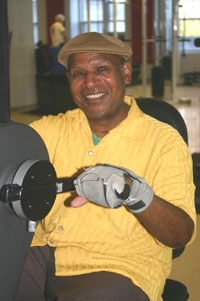By NCHPAD

Fitness center participant at the Rehabilitation Institute of Chicago
I don’t know about you, but I’m getting older. Thank goodness it’s not just me! It is estimated that by 2030, one out of every 5 Americans will be 65 years of age or older. As Baby Boomers age, society needs to change to accommodate demands of this growing percentage. So, what are we doing to meet the physical activity needs of this aging population and how are we making available opportunities known?
Not only is aging inevitable, but chronic disease, disability, mobility limitations, and other physical impairments increase as we age. Fun, huh? With the significant buying power of the Baby Boomers and the physical changes they face, the setting is primed for the development and marketing of accessible and inclusive programs, services, and facilities.
You may already have accessible and inclusive programs, services, and features, but how many people know about those? People with disabilities are often unaware of physical activity opportunities in their area despite their existence. The problem then, is marketing. How are people going to know about what is available if nobody reaches out to them, particularly if a prior experience in a fitness setting was less than positive (which certainly wouldn’t encourage me to seek more out)?
Here are some tips:
- Remember that disabilities come in a variety of forms: sensory (visual, hearing), cognitive, and physical. Consider as many types as possible when creating your marketing materials and strategies.
- Provide materials in various formats such as large print, Braille, electronic, and pictogram OR know how to get them upon request.
- Make sure your website and online materials are accessible (i.e. can be read by screen readers for visual impairments).
- Include images of people with various abilities, conditions, impairments, and body types in your materials. There has been a lot of attention on including all races and both sexes – expand that to people of all abilities too!
- Actively reach out. Post flyers or distribute brochures in community centers, independent living centers, physical therapy clinics and accessible housing common areas. Find an opportunity to attend a meeting to talk about your program.
- Build relationships with healthcare providers and encourage them to share information about your facilities and programs with patients, whether personally or in waiting areas. Once an individual leaves acute therapy or rehabilitation, community level fitness tends to be absent because people don’t know where to go next. Tell them!
- Highlight specific accommodations in your facility, like a pool lift or upper body ergometer. Make features stand out in your materials by using universal symbols of accessibility and highlight them on your tours. Even if one person doesn’t need a particular feature, chances are they know someone who does!
- On your membership form, ask if there is any need for accommodations. Often people do not identify as having a “disability” yet could use some sort of accommodation to use the facility to the fullest.
Older adults and individuals with disabilities are a growing population with money to spend and health needs to address. By reaching out, you are not only increasing your membership base, but are also helping to fill a significant need in their lives.
For more information on marketing to individuals with disabilities, go to
§ http://www.ncpad.org/fitt/fact_sheet.php?sheet=666
§ http://www.ncpad.org/fitt/fact_sheet.php?sheet=468
“So, what are you doing to meet the physical activity needs of this population and how are you making these opportunities known?”